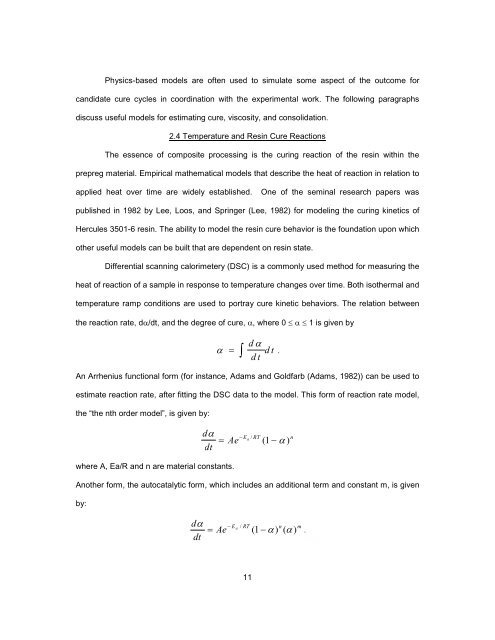TOOLED THICK COMPOSITES by ARVEN H. SAUNDERS III ...
TOOLED THICK COMPOSITES by ARVEN H. SAUNDERS III ...
TOOLED THICK COMPOSITES by ARVEN H. SAUNDERS III ...
Create successful ePaper yourself
Turn your PDF publications into a flip-book with our unique Google optimized e-Paper software.
Physics-based models are often used to simulate some aspect of the outcome for<br />
candidate cure cycles in coordination with the experimental work. The following paragraphs<br />
discuss useful models for estimating cure, viscosity, and consolidation.<br />
2.4 Temperature and Resin Cure Reactions<br />
The essence of composite processing is the curing reaction of the resin within the<br />
prepreg material. Empirical mathematical models that describe the heat of reaction in relation to<br />
applied heat over time are widely established. One of the seminal research papers was<br />
published in 1982 <strong>by</strong> Lee, Loos, and Springer (Lee, 1982) for modeling the curing kinetics of<br />
Hercules 3501-6 resin. The ability to model the resin cure behavior is the foundation upon which<br />
other useful models can be built that are dependent on resin state.<br />
Differential scanning calorimetery (DSC) is a commonly used method for measuring the<br />
heat of reaction of a sample in response to temperature changes over time. Both isothermal and<br />
temperature ramp conditions are used to portray cure kinetic behaviors. The relation between<br />
the reaction rate, dα/dt, and the degree of cure, α, where 0 ≤ α ≤ 1 is given <strong>by</strong><br />
α<br />
α = ∫ d<br />
d t .<br />
d t<br />
An Arrhenius functional form (for instance, Adams and Goldfarb (Adams, 1982)) can be used to<br />
estimate reaction rate, after fitting the DSC data to the model. This form of reaction rate model,<br />
the “the nth order model”, is given <strong>by</strong>:<br />
dα<br />
dt<br />
where A, Ea/R and n are material constants.<br />
− a /<br />
= Ae ( 1 − α )<br />
E RT n<br />
Another form, the autocatalytic form, which includes an additional term and constant m, is given<br />
<strong>by</strong>:<br />
dα<br />
= Ae<br />
dt<br />
− E a / RT<br />
11<br />
n m<br />
( 1 − α ) ( α )<br />
.
















